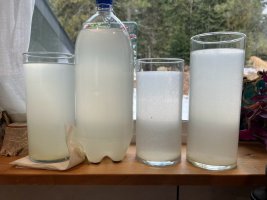vwguygti
New Member
Hi there - long time reader, first time poster here.
I have a 6 month old well that took a few weeks to clear up when new and since then occasionally would get murky. Here are some specs:
* 300’ deep well, pump set at 278’.
* 40’ of 6” steel case, remaining 4” pvc
* 40’ benonite seal
* 5 gpm, 15’ static water level
* first 30’ was sand, from 30’ to 105’ was decomposed granite, from there to 300’ was salt and pepper granite
I do have a 100 mesh spin down followed by a 5 micron whole house filter. I’ve been replacing the filter every month and regularly purging the spin down.
The water has become very silty and murky as of recent. For the last week, I’ve been running it a couple hours a day from the hydrant. Driller told me to keep doing what I’m doing to help clear it up. Results haven’t changed.
Any thoughts or recommendations would be greatly appreciated.
I’ve attached a picture - from left to right, water after 30 min, 1 hour, 1.5 hrs, 2 hrs… all at 3.5 gpm. These are pre filter from hydrant at well head.
I have a 6 month old well that took a few weeks to clear up when new and since then occasionally would get murky. Here are some specs:
* 300’ deep well, pump set at 278’.
* 40’ of 6” steel case, remaining 4” pvc
* 40’ benonite seal
* 5 gpm, 15’ static water level
* first 30’ was sand, from 30’ to 105’ was decomposed granite, from there to 300’ was salt and pepper granite
I do have a 100 mesh spin down followed by a 5 micron whole house filter. I’ve been replacing the filter every month and regularly purging the spin down.
The water has become very silty and murky as of recent. For the last week, I’ve been running it a couple hours a day from the hydrant. Driller told me to keep doing what I’m doing to help clear it up. Results haven’t changed.
Any thoughts or recommendations would be greatly appreciated.
I’ve attached a picture - from left to right, water after 30 min, 1 hour, 1.5 hrs, 2 hrs… all at 3.5 gpm. These are pre filter from hydrant at well head.

